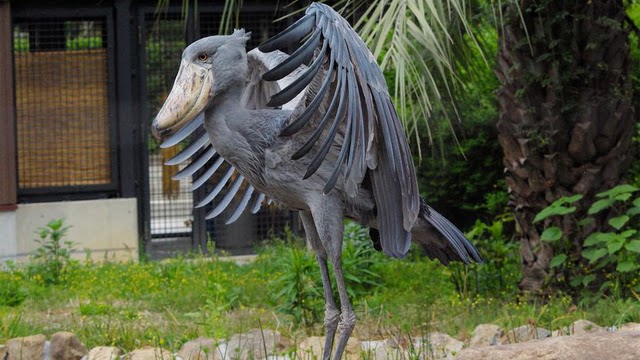Quck answer
The shoebill stork is a unique bird with a distinctive appearance. It has a large, powerful bill that resembles a shoe, giving it its name. This bird is native to Africa and is known for its impressive size, standing up to 5 feet tall. The shoebill stork is also a formidable predator, using its sharp bill to catch fish, reptiles, and even small mammals. Despite its intimidating appearance, the shoebill stork is a fascinating and important species that plays a crucial role in its ecosystem. However, the shoebill stork is also considered vulnerable due to habitat loss, making conservation efforts crucial to its survival.
Wild Animals

Meet the Balaeniceps rex, also known as the shoebill stork. This prehistoric-looking bird has been called “the most terrifying bird in the world,” “Monsterface,” and “Death Pelican.” It stands up to 5 feet (1.5 meters) tall with a wingspan that can reach 8 feet (over 2 meters). Its strange appearance and behavior make it a unique and fascinating creature.
The shoebill was originally classified with storks, but recent DNA research shows that it is actually more like herons and pelicans. It lives in the marshy swamps of East Africa, so it is rare to see it outside of that region.
While the shoebill looks intimidating, it is actually docile around humans. It moves slowly and stands still for long periods of time, making it easy to observe from a distance. It feeds on lungfish, tilapia, catfish, frogs, snakes, monitor lizards, and baby crocodiles, which it can swallow whole or tear apart with its powerful beak.
The shoebill is a monogamous bird that can live up to 35 years. It builds a floating nest with its mate, and the mother lays two or three eggs, but only one chick typically survives. The shoebill is a loner, and there are only 3,300 to 5,300 left in the wild.
Despite its solitary nature, the shoebill is a fierce fighter. It has been known to battle Nile crocodiles and hang out with hippos, which help bring its prey to the surface. During mating season or encounters with other shoebills, it makes a loud clattering noise with its bill.
Perhaps the most bizarre fact about the shoebill is that it defecates on its own legs to keep cool. But for this formidable bird, it’s just another quirk in its already strange and fascinating existence.
Interesting Fact
The shoebill bird’s eggs and young are highly sought after by poachers, who can make significant profits selling them on the illegal live bird market. Collectors in Saudi Arabia and Dubai have been known to pay $10,000 or more to obtain a shoebill for their personal collection. To combat this issue, Zambia’s Department of National Parks and Wildlife has partnered with a non-profit conservation organization to protect the endangered shoebill during breeding season since 2012.
FAQ
1. What is a shoebill stork?
A shoebill stork is a large bird native to East Africa. It is also known as the “whalehead” due to its enormous bill, which is shaped like a shoe.
2. How big is a shoebill stork?
Shoebill storks can grow up to 5 feet (1.5 meters) tall and can have a wingspan of up to 8 feet (2.4 meters). They can weigh up to 15 pounds (7 kg).
3. What do shoebill storks eat?
Shoebill storks primarily eat fish, but they also eat frogs, reptiles, and small mammals. They are known for their unique hunting technique, where they stand still in shallow water and wait for prey to swim by before striking with their powerful bill.
4. Where do shoebill storks live?
Shoebill storks are found in only a few countries in East Africa, including Uganda, Tanzania, and Zambia. They prefer to live in swamps, marshes, and other wetland areas.
5. What is the lifespan of a shoebill stork?
The lifespan of a shoebill stork is not well known, but it is estimated to be around 35 to 40 years in the wild.
6. Are shoebill storks endangered?
Yes, shoebill storks are considered to be a vulnerable species due to habitat loss and hunting for their meat and feathers. It is estimated that there are only around 5,000 to 8,000 individuals remaining in the wild.
7. Do shoebill storks mate for life?
Shoebill storks are thought to form long-term pair bonds, but there is not much information available about their mating behavior.
8. How do shoebill storks communicate with each other?
Shoebill storks are not very vocal and are mostly silent. They communicate using body language, such as bowing their heads or flapping their wings.
9. Are shoebill storks kept in zoos?
Yes, shoebill storks can be found in some zoos and wildlife parks around the world. However, they are not very common in captivity due to their specialized needs and the difficulty of breeding them successfully.
10. What is the conservation status of shoebill storks?
Shoebill storks are listed as a vulnerable species by the International Union for Conservation of Nature (IUCN). Several conservation efforts are underway to protect their habitat and raise awareness about their plight.
11. What is the cultural significance of shoebill storks?
Shoebill storks are an important cultural symbol in some parts of their range, and are considered to be a sacred bird by some African tribes. They are also a popular subject in African folklore and art.





Leave a Reply